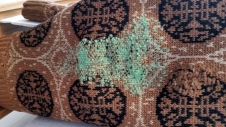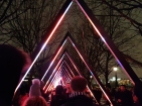Excellent news – I have been offered a Studio4 residency at Chisenhale Studios for 6 weeks giving me a dedicated space to develop new work. This has come at the perfect time for me to experiment with making video projections using cosmic particle trails to create an immersive experience. 
First tests will be to project images into the dark then ‘capture’ particle trails on various objects of differing opacity. Thinking about interactions of matter, tracing connections between invisible forces, ancient knowledge and the mysterious worlds of Muons and theoretical physics.
I think the number 12 will also be significant in this work and I will experiment with sound as well, looking at the 12 pitches of the chromatic scale and wondering how it might be possible to delineate a space with the 12 notes representing 12 planes.

I enjoyed the Radio 4 programme The Ideas That Make Us episode on Harmony.
The Chinese character for harmony comes from musical and culinary heritage where a mixing of ingredients creates balance – it is more than a joining of parts – it is a unified mingling of the different.
In music, the perception of a chord as dissonant or consonant depends on the intervals (in semitones) between tones. In empirical tests, the dissonance reported by listeners is greatest when two musical tones are separated by one or two semitones. All mammals prefer concordant music and harmonious sounds can actively reduce pain – harmony is not just a goal but a tool.

The harmony produced by mathematical ratios between the pitch of a note and the length of the string as determined by the Pythagoreans was extended to the whole cosmos – the music of the spheres – the planets also being governed by mathematical ratios. The Islamic garden with a geometrical layout creates a sense of harmonious symmetry; an integrated whole with balanced formal structures to reflect paradise on earth. Plato thought the human being in body and soul is actually a microcosm of the cosmic macrocosm, that our virtue and our flourishing is rooted in mathematical harmony and that pregnant women should dance rhythmically so their embryos gain a sense of harmony before they are born.

Just so the parts of Temples should correspond with each other, and with the whole. The navel is naturally placed in the centre of the human body, and, if in a man lying with his face upward, and his hands and feet extended, from his navel as the centre, a circle be described, it will touch his fingers and toes. It is not alone by a circle, that the human body is thus circumscribed, as may be seen by placing it within a square. For measuring from the feet to the crown of the head, and then across the arms fully extended, we find the latter measure equal to the former; so that lines at right angles to each other, enclosing the figure, will form a square. – Vitruvius in De architectura
There is an upcoming exhibition from Fred Butler Harmonics in Space at Now Gallery and this led me to look at the theories of Rudolf Laban. Many of his movement sequences are based on the patterns of the Platonic Solids which he recognised as patterns within everyday movements. The body moves through a sequence following the planes and vertices of the shape. He believed this opens the body to be more spatially aware and in turn balances the body spiritually.

I don’t know if he devised a sequence of movements for the dodecahedron, I will do some more research and would like to collaborate with a dancer to work on this idea as a way of moving through the planned installation.

The space harmony scales are based on the Trefoil knot and I wonder if this shape could be linked to a 3-sphere?
So this may be the maths but it is not a language I understand
In algebraic geometry, the trefoil can also be obtained as the intersection in C2 of the unit 3-sphere S3 with the complex plane curve of zeroes of the complex polynomial z2 + w3 (a cuspidal cubic).

After reading Kader Attia ‘The Loop’ recently where he discusses repair as a fundamental device of the universe in the regeneration of matter but also as a cultural concept Celia Pym’s Mending days series, as part of her Woman’s Hour Craft Prize work ‘Where Holes Happen’ at the V&A took on a resonant significance.
If the universe is finite and it would be possible to pass through one plane and arrive back in the same universe at another point is there a possibility that at these points of passage a tear could appear. Information would disappear into an alternative universe. The tear would quickly repair.

Metadata: How We Relate to Images organised by the international research group ‘Bilderfahrzeuge. Aby Warburg’s Legacy and the Future of Iconology‘ Technologies of Recording panel discussion in collaboration with CSM brought together academics, artists and archaeologists to debate different methods and reasons for recording objects questioning the production of knowledge. Apart from the familiar process of digital imaging ( though always good to stop and think what this means – a numeric representation, normally binary, of a two-dimensional image) I had to resort to Wikipedia to find out some of what they were talking about – Photogrammetry (The input to photogrammetry is photographs, and the output is typically a map, a drawing, a measurement, or a 3D model of some real-world object or scene). Spectral imaging (Spectral imaging is a branch of spectroscopy and of photography in which a complete spectrum or some spectral information (such as the Doppler shift or Zeeman splitting of a spectral line) is collected at every location in an image plane). RTI (Polynomial texture mapping, also known as Reflectance Transformation Imaging (RTI), is a technique of imaging and interactively displaying objects under varying lighting conditions to reveal surface phenomena). These techniques allow an object to be visualised in great detail, especially RTI which can reveal traces of process in an artefact, even fingerprints. From this process of recording new products are created.
In the 19th Century a paper mould technique was used, developed by Lottin de Laval who encouraged a DIY approach though his published manual. Wet paper was layered over the artefact to be recorded, the mould was dried and used as a plaster cast to reconstruct the object. The paper mould was very popular and used to great effect by archaeologists like Alfred Maudslay in recording architecture in faraway places. The mould acted as a transmitter of information and often destroyed in the process of casting. It would also destroy that which it recorded as it would take paint and material from the building in the recording process.

We previously relied on drawn images and language descriptions which would be open to interpretation and subjectivity.
Questions that arose – How much knowledge is contained in methods of recording for the artist and for the archaeologist? How reliable is documentation? Is the new artefact – the digital image autonomous?
The new methods of recording call for a new language to develop alongside. There is a consciousness in the field to avoid language which denotes a hierarchy of copy and original so often a metaphor or analogy such as ghost object is used. The aura of an original is still very valuable.
Melanie King’s work explores how light from incredibly distant stars can be captured directly onto photosensitive film giving each print an aura of direct entanglement.

As part of the Ancient Light exhibition at the Blyth Gallery, Imperial College London. Melanie King and theoretical cosmologist Dr Roberto Trotta discussed The Language of the Stars.
Roberto shared his fascination of how the relationship between theory and physical observation in cosmology came about. The mathematical language used to describe cosmological observations is mirrored by the information found in the light itself. Observation leads to theory which leads to observation, staggering and staggered and both reaching the same conclusions.
Thinking about the language used in cosmology and the arts they considered what it means to describe something using an expanded vocabulary (is this greater knowledge if there are more words to describe the phenomena) or a capped language (this made me think about the traveller encountering something new in the world and having to describe it more fully to explain what it was, not having the actual word to hand). Melanie has been looking at Robert Macfarlane’s mission to keep language alive as words slip from use and Roberto from his experience writing “The Edge of The Sky: All You Need to Know about the All-There-Is” a book about discoveries and mysteries in cosmology using only 1,000 most common words in the English language. I was dismayed to hear that according to the new OUP Junior Dictionary a modern child no longer needs a definition for words that were a dominant part of my own childhood such as a newt, hazel or acorn. All cultures develop language according to their needs.
Looking at the stars. Naming is possession. Civilizations were built on reading the night sky. Gazing up at the constellations invokes in us a primordial response. The difficulty is how to translate that visceral experience of a personal encounter with the sublime into language, visual or otherwise.

Lumen Exhibition at The Crypt Gallery shows work following on from the Atina Residency spent stargazing in Italy

Louise Beer In the Beginning (still)

Juan Diego Garza
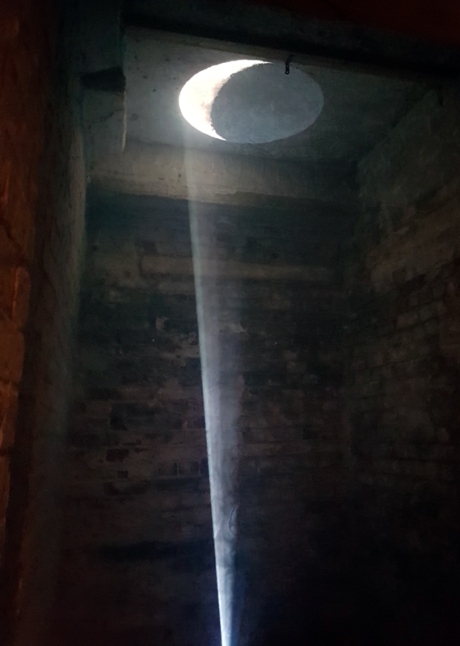
Helen Cawley Three Hundred and Sixty Hours (still)
core of a S.A.D. light therapy lamp – most accurate artificial reproduction of sunlight

Chiara Bugatti Habitat (10000lux, 5900k)
and this beautiful work from my studio neighbour

Charmaine Watkiss Untold
No stars to be seen over London. Instead we gaze at the lights of London Lumiere.


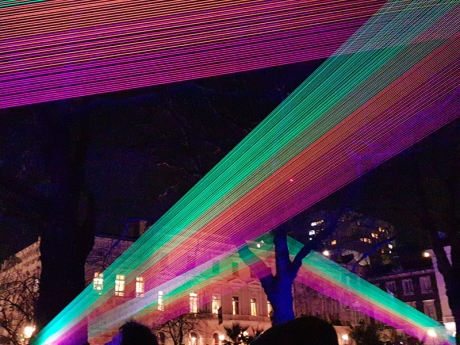
The Illusion of Permanence a collaboration between Gavin Mitchell and Ian Carr at the Thames-side Gallery. iPhone images converted to 35mm slides, randomly sequenced to create new narratives.
Lovely swooshing sound like bamboo rustling from Disco Vision as the discs spin to form a new image, pause and spin again; hypnotic.
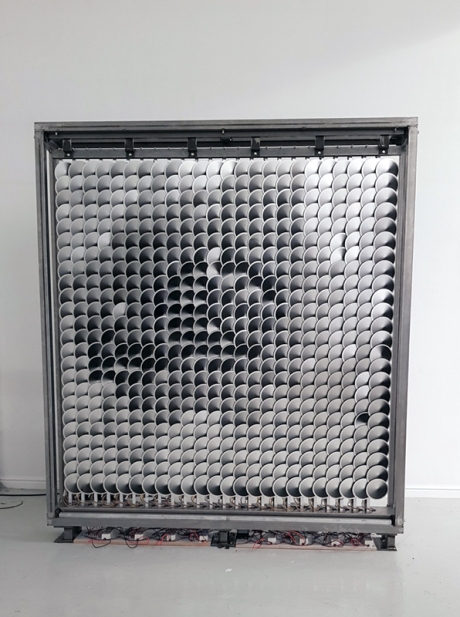
Disco Vision Kinetic Installation with discs synchronised to reproduce images by spinning each disc to reveal more or less tone. Created by AMD Interior Architecture
The sculptural installation TRANSitions from James Seow in collaboration with Carl Fraser took ghostly form in a repurposed North London water pumping station.

James Seow / Carl Fraser TRANSitions
What might be some organism originating in the depths of the ocean, translucent, winding searching for a lost watery home.

James Seow / Carl Fraser TRANSitions
Ana Mendieta:Body Tracks screening of The Earth That Covers Us Speaks at Tate Modern took me back to text written in my MA dissertation.

Ana Mendieta Burial Pyramid 1974
Ana Mendieta equates being expelled from her homeland Cuba at an early age with being torn from the womb of the earth. She suffers profoundly the human condition of nostalgia for a place she can’t return to. Memories of her childhood lived in a culture still in tune with ancient ritual and custom inspire her need to make work that echoes the mystic beliefs of the past. She investigates the primary relationship of humanity with the earth as mother. Through her work the separation between her own body and nature is absolved by the mud and blood she plasters over herself reducing all to matter. Through tapping into the ancient spirits of a primordial age and using the same elements of earth, fire and blood in her art as her ancestors used in their rituals her intention is to infuse her work with power and magic. She works on a human scale “in connection with the Palaeolithic spirit. As opposed to the industrial spirit” leaving little trace in the landscape.
The repetition of the human form blending into the landscape in her Siluetas shows a constant desire to become one with the earth, to be in that embryonic state of dependency with the creator before nature becomes other. In her work the human figure within the tableau becomes increasingly indistinct as it slips progressively into the landscape and disappears.

Ana Mendieta Imagen de Yagul 1973
When we look at Siluetas such as ‘Imagen de Yagul’ and see a body covered in flowers, we cannot help but think of death. The female form described by delicate stems appears infected by a bloom of mildew. These pieces hold the spell of ritual, of burial ground. She returns her body to its corporeal elements being absorbed back into the earth. The choice presented, to be truly one with nature, is either to be held unconscious in the embrace of the womb or to suffer the final closure of death.
If harmony is a mingling does this lead to entanglement, a state where the separate entities are no longer distinguishable. RCA PGR/PHD Research Group: Entanglement present RCA | Visual Cultures Lecture Series| Marl: Sometimes Hard, usually Soft: A Carnival of Entanglement an evening of performance and screenings embracing supra-natural brain wave performance, applying the laws of physics to information, following threads in meaning through language, theoretical art: binary primitivism, censorship, self harm, algorithms and alchemy.

Amir George Decadent Asylum (still)
The video work Decadent Asylum, by Amir George, is a folkloric narrative of a soul-searching told in three parts. The pupil becomes the practitioner, and the practitioner becomes the alchemist. One becomes other. At one with the other.




